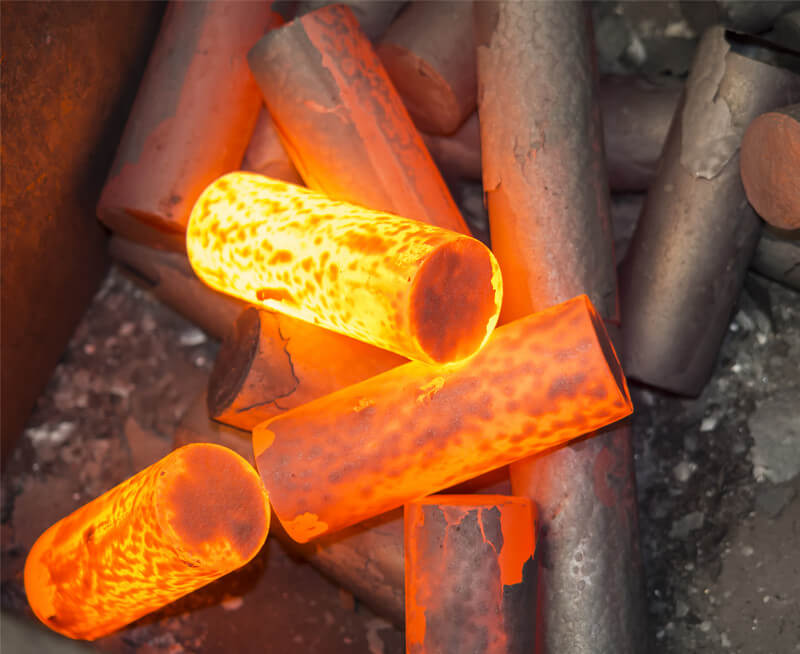
The Application Of Forging Process In Automotive Lightweighting
September 4, 2021
Determination and Analysis Of Forging Process Plan
October 13, 2021What Are The Advantages Of Cold Forging Radiators In LED Heat Dissipation?
The cold forging process is all about forging products at room temperature. Cold forged products have a high shape and dimensional accuracy, good internal density, high strength, smoother surface, and requires few processing procedures, unlike other forging and forming methods, and is convenient for mass production.
Here are some of the major advantages of cold forging radiators for LED heat dissipation:
-
Good Thermal Conductivity
The cold forging radiators are mostly formed by forging pure aluminum AL1070 and AL1050. The thermal conductivity of pure aluminum AL1070 is 226W/mk but under the cold forging process, the internal structure will be denser, and this means the actual thermal conductivity of the finished forgings could be higher than that of raw material pure aluminum.
The thermal conductivity of alloy aluminum AL6063 is 180W/ mk, while the thermal conductivity of ordinary die-cast aluminum A380 is only 96W/mk. Note that the greater the thermal conductivity, the faster the heat released by the LED is conducted. This means cold forging is better as it is more conducive to the overall heat dissipation of the LED lamp.
-
Good Heat Dissipation Structure
The design of the radiators is to maximize heat dissipation. The radiator base plate (bottom plate) and the fins are integrally formed without any gaps between them when cold forged. The heat of the substrate can be conducted to the heat dissipation fins without barriers.
For automotive aluminum parts and brazed parts, the heat dissipation substrate and the heat sink are riveted or brazed together after machining. There is usually a gap between them and this means indirect thermal resistance is generated. The thermal expansion and cooling during the use of the lamp can cause a gap to be generated and enlarged.
This is what increases the thermal resistance, which is not conducive to the conduction of heat. The cold forging of the radiators formed one complete piece hence better heat dissipation features.
-
Multiple Choices Of Materials
A lot of materials can be used for the construction of the cold forging radiators. The AL1070 pure aluminum series materials can be used for cold forging, as well as the AL6063 series materials. The two materials can use the same set of molds, thereby increasing customer choices to meet different needs!
-
Different Product Structure
With cold forging, you have a range of structures to select from. For example, both the upper and lower sides of the bottom plate can be cold-forged to form a heterogeneous structure. The two sides can also be stamped into special shapes to ensure that there is a heterogeneous structure on the back of the substrate, to better integrate with the heating element.
-
Small Size and Light Weight
Compared with other available options such as die-casting parts, brazing parts, and automotive aluminum parts, pure aluminum cold-forged radiators have the advantage of offering a vaster range of sizes and weights. For example, you can have the same traditional 5W radiator in terms of shape and volume producing achieve 7W with the cold forged pure aluminum. Pure aluminum cold-forged radiators reduce the overall weight and volume of LED lamps, reduce the overall cost, and at the same time make the product more competitive.
-
Large Heat Dissipation Area
The heat dissipation area is a critical factor for an effective LED lamp heat dissipater. The thickness of the cooling fins of most cold-forged radiators can be up to 0.7mm, and the spacing can be 1mm. In fact, the aspect ratio is above 1:50. The thin and more radiating fins greatly increase the contact area with the air. This means more conducive to air convection and heat dissipation.
-
Exquisite Appearance
The smooth surface of the cold-forged radiator is smooth compared to that of cast aluminum. The surface can be anodized to make it bright and beautiful, and it can also be anodized in different colors like silver, white, black, according to the customer needs. The surface of die-cast aluminum is rough and may need to be sprayed to improve its appearance. Unfortunately, spays are not conducive to heat dissipation.
In summary, cold-forged radiators provide the best solutions for the heat dissipation of high-power LED lighting fixtures. Depending on the customer’s design and assembly requirements CXIN Forging will tailor-made professional customized LED cold forging radiators with different structures. Send us your needs at sales@cxinforging.com, and we will serve you wholeheartedly.




